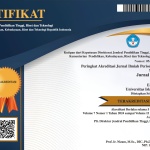Electoral Law Innovation to Strengthen Women's Representation in Parliament
Abstract
In a healthy democratic system, it is important to involve women and men in policy-making and decision-making processes to achieve balance and justice. In Indonesia, despite the requirement for 30% female candidates for parliamentary positions, the representation of women elected remains below this target. This study uses a juridical-normative method with conceptual, legislative, and comparative approaches to answer how to ensure at least 30% female representation in parliament. The findings show that the current electoral system affects the low level of female election success, especially with the plurality voting system that presents significant challenges for women. Currently, Indonesia implements a gender quota as a candidate quota, which only mandates the nomination of 30% of women. However, its implementation has been ineffective as women still struggle to be elected, particularly under the open proportional system. To ensure at least 30% female representation, Indonesia needs to consider adopting a gender quota system like the reserved seat model, as applied in Rwanda, which allocates 30% of parliamentary seats for women, or in Uganda, where seats are specifically allocated for women in each district, thus increasing the chances for women to be elected.
Keywords
Full Text:
PDFReferences
Journals:
Deen, Thaufiq., Ong Argo Victoria & Sumain. 2018. Public Notary Services in Malaysia. JURNAL AKTA, Vol. 5, No. 4: p.1017-1026. Doi: 10.30659/akta.v5i4.4135, accessed from https://jurnal.unissula.ac.id/index.php/akta/article/view/4135
Dahlerup, D., & Freidenvall, L. (2005). Quotas as a ‘fast track’ to equal representation for women. International Feminist Journal of Politics, 7(1), 26–48. https://doi.org/10.1080/1461674042000324673.
Hevriansyah, A. (2021). Hak Politik Keterwakilan Perempuan dalam Sistem Proporsional Representatif pada Pemilu Legislatif. Awasia: Jurnal Pemilu Dan Demokrasi, 1(1), 67–85.
Judiasih, S. D. (2022). Implementasi kesetaraan gender dalam beberapa aspek kehidupan bermasyarakat di Indonesia. ACTA DIURNAL Jurnal Ilmu Hukum Kenotariatan, 5(2), 284–302.
Kurniaty, E. Y. (2015). Affirmative Action: Reservation Seats untuk Perempuan di Parlemen India. JPPUMA: Jurnal Ilmu Pemerintahan Dan Sosial Politik UMA (Journal of Governance and Political UMA), 3(2), 187–196.
Kurniawan, N. (2016). Keterwakilan Perempuan Di Dewan Perwakilan Rakyat Pasca Putusan Mahkamah Konstitusi Nomor 22-24 PUU-VI 2008. Jurnal Konstitusi, 11(4), 714–736. https://doi.org/10.31078/jk1146.
Mansbridge, J. (2011). Clarifying the Concept of Representation. The American Political Science Review, 105(3), 621–630. https://www.jstor.org/stable/41480861.
Rafni, A. (2020). Kesetaraan Gender dalam Politik: Pembinaan Kader Perempuan oleh Partai Politik, Upaya Menuju Penguatan Kapasitas Legislatif Daerah. Jurnal Ilmiah Kajian Gender.
Tias, R. N., Nisrina, A. D., Destriputra, N., Al Putra, F. A., & Prakoso, S. G. (2023). Tantangan Kebijakan Affirmative Action Sebagai Upaya Penguatan Keterwakilan Perempuan di Legislatif. Jurnal Politica Dinamika.
Books:
Bhirawati, Y. R. (2000). Meningkatkan Partisipasi Politik Perempuan Melalui Proses Konstitusional dan Pemilu. IDEA-CETRO.
Budiarjo, M. (2008). Dasar-Dasar Ilmu Politik (C. Pertama (Ed.)). Gramedia Pustaka Utama.
Clayton, D., & Faye, J. (2001). Justice, Gender and Affirmative Action BT - Panduan Parlemen Indonesia (A. W. Soejipto (Ed.)).
Dahlerup, D. (2002). Using Quotas to Increase Women’s Political Participation BT - Women in Parliament Beyond Numbers (J. Ballington & A. Karam (Eds.)). International IDEA.
Dahlerup, D. (2005). Increasing Women’s Political Participation: New Trends in Gender Quotas BT - Women in Parliament: Beyond Numbers (J. Ballington & A. Karam (Eds.)). International IDEA.
Deklarasi Universal Hak-Hak Asasi Manusia (DUHAM). (n.d.).
El-Muhtaj, M. (2005). Hak Asasi Manusia dalam Konstitusi Indonesia (I. Cetakan (Ed.)). Kencana.
Lovenduski, J. (2008). Politik Berparas Perempuan. Kanisius.
Marijan, K. (2011). Sistem politik Indonesia: Konsolidasi demokrasi pasca orde baru. Kencana.
Nugroho, R. (2008). Gender dan Strategi: Pengurus Utamannya di Indonesia. Pustaka Pelajar.
Pedoman Teknis Penyusunan Rencana Aksi Tujuan Pembangunan Berkelanjutan (TPB)/Sustainable Development Goals (SDGs) (Edisi II). (2020). Kementerian Perencanaan Pembangunan Nasional/Badan Perencanaan Pembangunan Nasional.
Pitkin, H. F. (1967). The Concept of Representation. University of California Press.
Rishan, I. (2020). Hukum & Politik Ketatanegaraan. FH UII Press.
Suparto, D. (2021). Membangun Kesadaran dan Partisipasi Politik Masyarakat. CV. Cendekia Pers.
Internet:
Diamond, L. (2004). What is Democracy? https://www.standard.edu/∼/diamond/Iraq/whalsDemocracy012004.htm.
Proportion of Seats Held by Women in Tanzania National Parliament. (n.d.). https://www.statista.com/statistics/1248349/proportion-of-seats-held-by-women-in-tanzania-national-parliament/.
Subono, N. I. (2009). Representasi Politik Perempuan yang Lebih Bermakna. Jurnal Sosial, 6(2), 56–61. https://library.fes.de/pdf-%0Afiles/bueros/indonesien/07003%0A.
True, J., Parashar, S., & George, N. (2012). Women’s Political Participation in Asia and the Pacific. https://www.artsonline.monash.edu.au
Women in Selected National Parliaments. (n.d.). https://data.ipu.org/women-ranking?month=2&year=2024
DOI: https://dx.doi.org/10.30659/jdh.v8i3.44885
Refbacks
- There are currently no refbacks.
View My Stats

This work is licensed under a Creative Commons Attribution 4.0 International License.
Jurnal Daulat Hukum has been indexed in:

